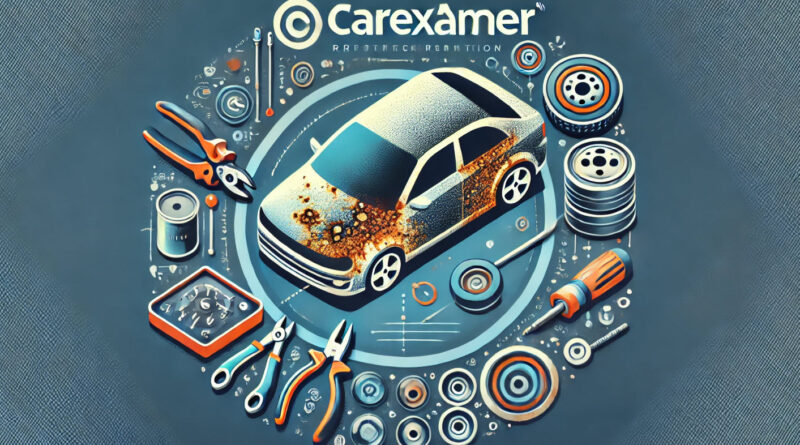Car Rust Guide: How to Remove and Prevent It
This guide will walk you through how to remove rust from your car and, more importantly, how to prevent it from returning. Rust is the silent enemy of vehicles, creeping in slowly and causing significant damage if left untreated. Not only does rust affect the appearance of your car, but it can also compromise the vehicle’s structural integrity, leading to costly repairs or even safety issues.
What Causes Car Rust?
Rust forms when iron or steel reacts with oxygen and moisture. This chemical reaction creates iron oxide, more commonly known as rust. Several factors can accelerate the rusting process, including:
- Salt: Especially in areas where roads are salted during winter, salt can speed up the rusting process by lowering the freezing point of water, allowing more moisture to stay in contact with the metal.
- Humidity: High humidity levels provide the moisture necessary for rust to form, especially in coastal areas.
- Scratches and Chips: Exposed metal due to scratches or chips in the paint allows rust to form more easily.
How to Remove Rust from Your Car
If you’ve noticed rust spots on your vehicle, it’s important to act quickly before the rust spreads. Here’s how you can remove rust from your car:
1. Gather Your Supplies
- Sandpaper or a wire brush
- Rust converter or primer
- Automotive paint that matches your car’s color
- Clear coat
- Masking tape and plastic sheeting
- Microfiber cloths
2. Prepare the Area
- Start by washing the rusted area with soap and water to remove any dirt or debris. Dry the area thoroughly with a microfiber cloth.
- Use masking tape and plastic sheeting to cover the surrounding areas to protect them from dust and paint.
3. Remove the Rust
- Use sandpaper or a wire brush to scrub the rusted area until you reach bare metal. Make sure to remove all traces of rust, as even a small amount left behind can continue to spread.
- If the rust has created holes, you may need to use a rust converter. This chemical solution transforms rust into a stable compound that can be painted over.
4. Apply Primer
- Once the rust is removed, apply a rust-inhibiting primer to the bare metal. This will prevent new rust from forming and provide a good base for the paint.
5. Paint the Area
- After the primer has dried, apply automotive paint that matches your car’s color. Apply several thin coats, allowing each coat to dry before applying the next.
6. Apply Clear Coat
- Finish the repair by applying a clear coat over the painted area. This will protect the paint and give it a glossy finish that matches the rest of your car.
7. Buff the Area
- Once the clear coat is dry, use a microfiber cloth to buff the area, blending it with the surrounding paint.
How to Prevent Rust on Your Car
Preventing rust is much easier and less costly than repairing it. Here are some effective ways to keep rust at bay:
1. Regularly Wash and Wax Your Car
- Dirt, salt, and other contaminants can trap moisture against your car’s metal surfaces, leading to rust. Regularly washing your car, especially during winter months, removes these contaminants.
- Applying wax provides a protective barrier against moisture and helps prevent scratches that can expose metal.
2. Inspect and Repair Paint Chips
- Even small chips or scratches in your car’s paint can expose the underlying metal to moisture and oxygen, leading to rust. Inspect your car regularly and touch up any chips or scratches with automotive paint.
3. Apply Rustproofing
- Consider applying a rustproofing treatment to your car, especially if you live in an area prone to rust. Rustproofing sprays and undercoatings can provide an extra layer of protection against moisture.
4. Keep Your Car Dry
- Moisture is the primary cause of rust, so keeping your car dry is crucial. If possible, store your car in a garage or under a car cover to protect it from rain and snow. After washing your car, make sure it’s completely dry before driving or storing it.
5. Avoid Parking on Grass or Dirt
- Parking your car on grass or dirt exposes it to moisture from the ground, which can speed up the rusting process. Whenever possible, park on concrete or asphalt.
6. Use Anti-Rust Spray
- Applying an anti-rust spray to the undercarriage of your car can help prevent rust from forming in areas that are prone to moisture and road salt.
Rust can be a major issue for car owners, but with the right care and attention, it’s possible to keep your vehicle looking and running like new. Regular maintenance, such as washing and waxing, along with prompt repairs of any paint damage, will go a long way in preventing rust. If rust does appear, acting quickly to remove it can prevent further damage and costly repairs. By following these tips, you can protect your car from the damaging effects of rust and extend its lifespan.
Buying a used VW. Buying used vauxhall, BMW, Jaguar, Ford, Volvo, Range rover, Bentley, Aston Martin, Porsche, Ferrari, Lamborghini, Maserati, Hyundai, Tesla, Honda, Pagani

